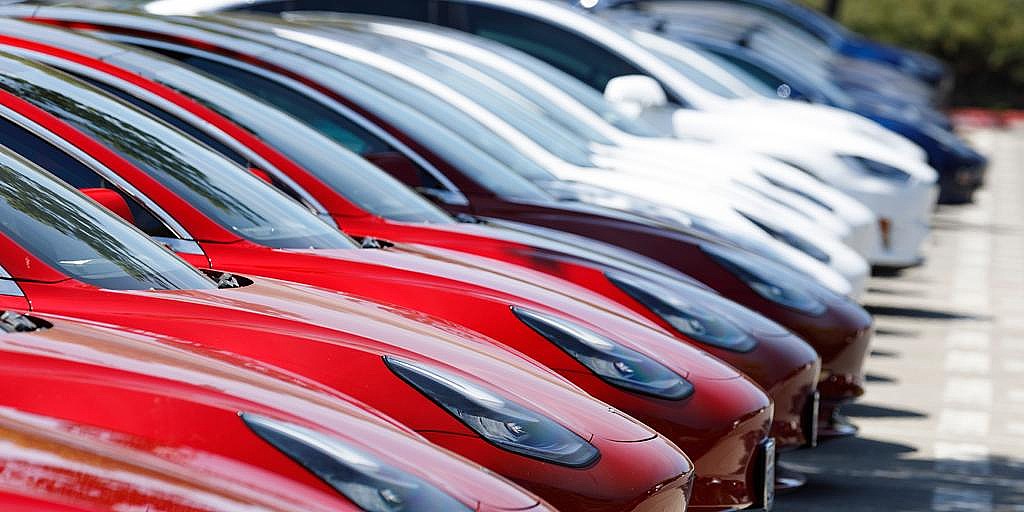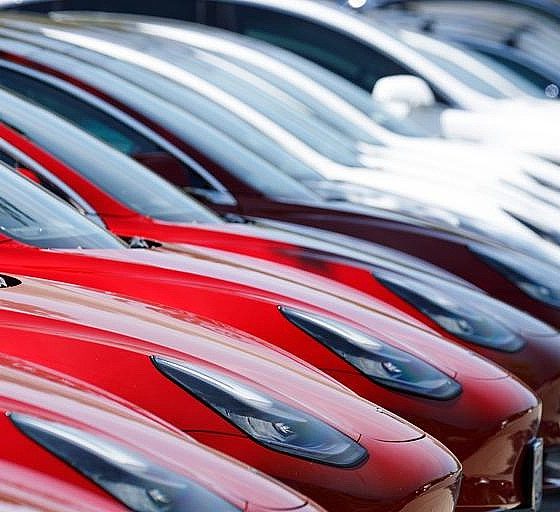The Biden Administration is pulling back on a proposed rule that would require automakers to build fewer combustion engine vehicles or face hefty fines.
On Tuesday, the Department of Energy decided to slow down the phase-out of existing rules that give car companies extra fuel-economy credits for the EVs they sell. The goal was to help U.S. car companies meet federal fuel efficiency standards while maintaining the ability to sell gas-powered pickups and SUVs that are big money makers.
The Biden White House decided to pull back the rules after meeting with automakers who said they could not meet the aggressive goals for a widespread EV transition.
The previous rules aimed to have 67 percent, or roughly two-thirds, of all new cars be electric by 2032. The new rules now allow for 30 to 56 percent of all new car sales to be EVs.
BREAKING
You might not own an electric vehicle by 2032, after all.
The EPA is *easing* its emissions rule ramp-up after major concerns from the car industry.
Percentage of EVs by 2032:
Previous plan: 67%
Current plan: 30-56%Dealers and consumers – how do you feel about…
— Car Dealership Guy (@GuyDealership) March 20, 2024
Last year, the U.S. EV market share was under 8 percent.
Tesla wants the U.S. to enact stricter fuel efficiency standards
The backpedaling comes as President Biden is attempting to bolster his re-election campaign. Reuters, in its report, points out that the move could be an attempt to sway some votes in his direction as the battleground state of Michigan, where General Motors and Ford, two legacy automakers, are based.
The Biden Administration’s concession comes as Donald Trump has stated that the heavy EV policies could cost millions of jobs and help Chinese EV makers dominate the growing U.S. EV sector.
The now-pulled-back proposal would have lowered “petroleum-equivalent fuel economy” ratings for EVs by 72 percent in 2027. By 2030, they would have been reduced by a total of 65 percent, giving companies more time to adjust to the strict standards.
Companies supported the announcement after they disclosed to the White House that meeting these standards would become increasingly difficult.
The Reuters report also states that GM would have faced $6.5 billion in fines, Stellantis would have been stuck with a $3 billion penalty, and Ford would have had $1 billion in fines.
The EPA also announced on Wednesday that it would implement revised standards for vehicle emissions from 2027 to 2032.
These new rules will require emissions reductions in every new car sold starting in 2027. To meet the new standards, automakers will be able to utilize cleaner technologies for gas-powered cars and add more zero-emissions EVs to their lineups.
The final rule would help the industry meet the limits of 56 percent of new vehicle sales being all-electric by 2032. It would also see at least 13 percent of new car sales be hybrid vehicles.
“Let me be clear: Our final rule delivers the same, if not more, pollution reduction than we set out in our proposal,” the EPA’s Michael Regan said, according to NBC.
“Today’s announcement will shift the trajectory of the automobile market and put us on a path to real emissions reductions, with an estimated 7.2 billion tons of global warming pollution avoided by 2055,” Steven Higashide, Director of the Clean Transportation Program at the Union of Concerned Scientists, said. “These rules are the strongest standards ever finalized and vital for meeting U.S. climate goals. This rule is technology-neutral and won’t mandate electric vehicles, but it will encourage this growing market. New cars sold in the coming years will be on the road for a decade or more, so it’s vital that these rules cut emissions from gasoline cars as well as encourage zero-emission electric cars.”
The new regulations are more aligned with the automotive industry’s beliefs. Dealers and the UAW saw previous plans from the EPA as unrealistic.
However, climate groups believe these standards will help eliminate emissions.
“These standards will help clean up emissions from transportation—the biggest source of global warming pollution in the U.S. To achieve their full potential, these rules must be accompanied by other investments in a cleaner, more accessible transportation system,” Higashide added.
I’d love to hear from you! If you have any comments, concerns, or questions, please email me at joey@teslarati.com. You can also reach me on Twitter @KlenderJoey, or if you have news tips, you can email us at tips@teslarati.com.

News
Tesla starts showing how FSD will change lives in Europe
Local officials tested the system on narrow country roads and were impressed by FSD’s smooth, human-like driving, with some calling the service a game-changer for everyday life in areas that are far from urban centers.

Tesla has launched Europe’s first public shuttle service using Full Self-Driving (Supervised) in the rural Eifelkreis Bitburg-Prüm region of Germany, demonstrating how the technology can restore independence and mobility for people who struggle with limited transport options.
Local officials tested the system on narrow country roads and were impressed by FSD’s smooth, human-like driving, with some calling the service a game-changer for everyday life in areas that are far from urban centers.
Officials see real impact on rural residents
Arzfeld Mayor Johannes Kuhl and District Administrator Andreas Kruppert personally tested the Tesla shuttle service. This allowed them to see just how well FSD navigated winding lanes and rural roads confidently. Kruppert said, “Autonomous driving sounds like science fiction to many, but we simply see here that it works totally well in rural regions too.” Kuhl, for his part, also noted that FSD “feels like a very experienced driver.”
The pilot complements the area’s “Citizen Bus” program, which provides on-demand rides for elderly residents who can no longer drive themselves. Tesla Europe shared a video of a demonstration of the service, highlighting how FSD gives people their freedom back, even in places where public transport is not as prevalent.
What the Ministry for Economic Affairs and Transport says
Rhineland-Palatinate’s Minister Daniela Schmitt supported the project, praising the collaboration that made this “first of its kind in Europe” possible. As per the ministry, the rural rollout for the service shows FSD’s potential beyond major cities, and it delivers tangible benefits like grocery runs, doctor visits, and social connections for isolated residents.
“Reliable and flexible mobility is especially vital in rural areas. With the launch of a shuttle service using self-driving vehicles (FSD supervised) by Tesla in the Eifelkreis Bitburg-Prüm, an innovative pilot project is now getting underway that complements local community bus services. It is the first project of its kind in Europe.
“The result is a real gain for rural mobility: greater accessibility, more flexibility and tangible benefits for everyday life. A strong signal for innovation, cooperation and future-oriented mobility beyond urban centers,” the ministry wrote in a LinkedIn post.
News
Tesla China quietly posts Robotaxi-related job listing
Tesla China is currently seeking a Low Voltage Electrical Engineer to work on circuit board design for the company’s autonomous vehicles.

Tesla has posted a new job listing in Shanghai explicitly tied to its Robotaxi program, fueling speculation that the company is preparing to launch its dedicated autonomous ride-hailing service in China.
As noted in the listing, Tesla China is currently seeking a Low Voltage Electrical Engineer to work on circuit board design for the company’s autonomous vehicles.
Robotaxi-specific role
The listing, which was shared on social media platform X by industry watcher @tslaming, suggested that Tesla China is looking to fill the role urgently. The job listing itself specifically mentions that the person hired for the role will be working on the Low Voltage Hardware team, which would design the circuit boards that would serve as the nervous system of the Robotaxi.
Key tasks for the role, as indicated in the job listing, include collaboration with PCB layout, firmware, mechanical, program management, and validation teams, among other responsibilities. The role is based in Shanghai.
China Robotaxi launch
China represents a massive potential market for robotaxis, with its dense urban centers and supportive policies in select cities. Tesla has limited permission to roll out FSD in the country, though despite this, its vehicles have been hailed as among the best in the market when it comes to autonomous features. So far, at least, it appears that China supports Tesla’s FSD and Robotaxi rollout.
This was hinted at in November, when Tesla brought the Cybercab to the 8th China International Import Expo (CIIE) in Shanghai, marking the first time that the autonomous two-seater was brought to the Asia-Pacific region. The vehicle, despite not having a release date in China, received a significant amount of interest among the event’s attendees.
Elon Musk
Elon Musk and Tesla AI Director share insights after empty driver seat Robotaxi rides
The executives’ unoccupied tests hint at the rapid progress of Tesla’s unsupervised Robotaxi efforts.

Tesla CEO Elon Musk and AI Director Ashok Elluswamy celebrated Christmas Eve by sharing personal experiences with Robotaxi vehicles that had no safety monitor or occupant in the driver’s seat. Musk described the system’s “perfect driving” around Austin, while Elluswamy posted video from the back seat, calling it “an amazing experience.”
The executives’ unoccupied tests hint at the rapid progress of Tesla’s unsupervised Robotaxi efforts.
Elon and Ashok’s firsthand Robotaxi insights
Prior to Musk and the Tesla AI Director’s posts, sightings of unmanned Teslas navigating public roads were widely shared on social media. One such vehicle was spotted in Austin, Texas, which Elon Musk acknowleged by stating that “Testing is underway with no occupants in the car.”
Based on his Christmas Eve post, Musk seemed to have tested an unmanned Tesla himself. “A Tesla with no safety monitor in the car and me sitting in the passenger seat took me all around Austin on Sunday with perfect driving,” Musk wrote in his post.
Elluswamy responded with a 2-minute video showing himself in the rear of an unmanned Tesla. The video featured the vehicle’s empty front seats, as well as its smooth handling through real-world traffic. He captioned his video with the words, “It’s an amazing experience!”
Towards Unsupervised operations
During an xAI Hackathon earlier this month, Elon Musk mentioned that Tesla owed be removing Safety Monitors from its Robotaxis in Austin in just three weeks. “Unsupervised is pretty much solved at this point. So there will be Tesla Robotaxis operating in Austin with no one in them. Not even anyone in the passenger seat in about three weeks,” he said. Musk echoed similar estimates at the 2025 Annual Shareholder Meeting and the Q3 2025 earnings call.
Considering the insights that were posted Musk and Elluswamy, it does appear that Tesla is working hard towards operating its Robotaxis with no safety monitors. This is quite impressive considering that the service was launched just earlier this year.










